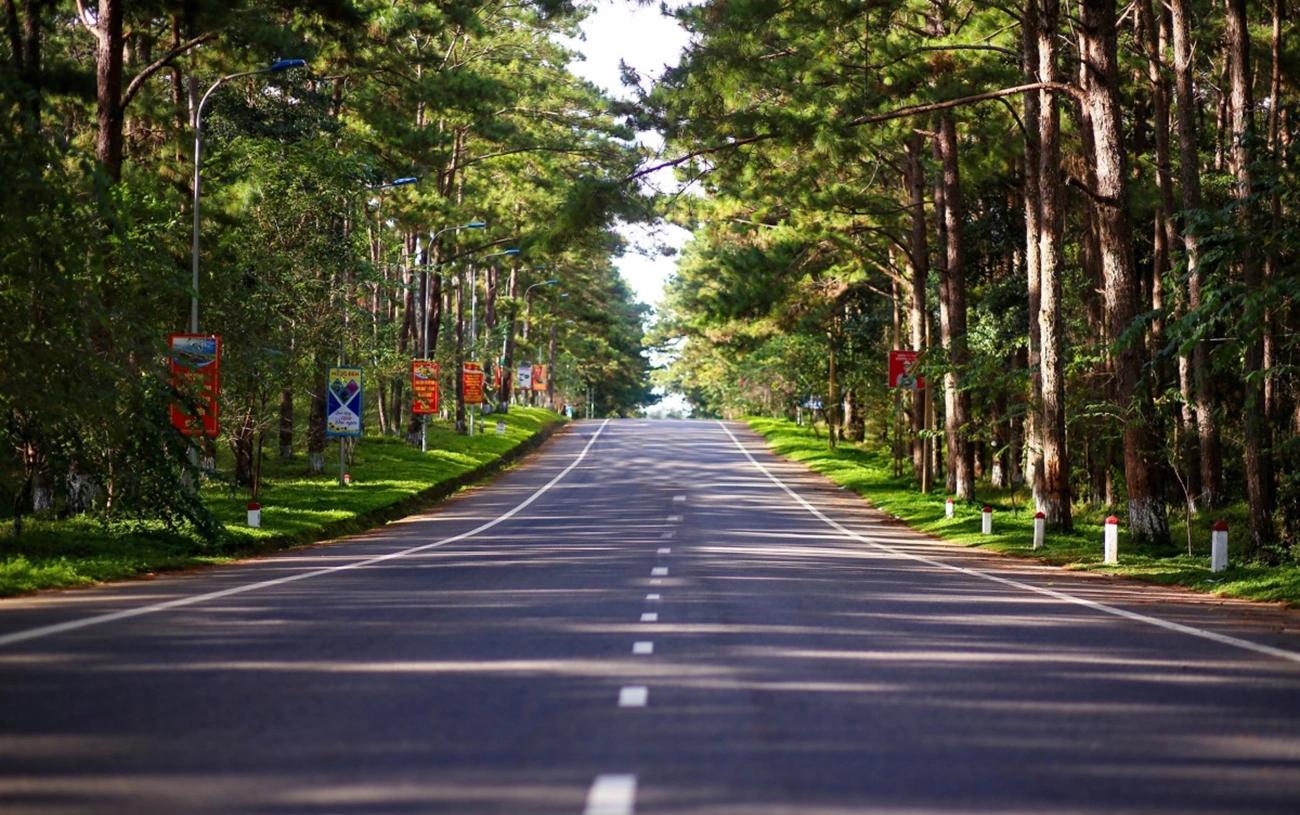
Nestled amid the sunny and breezy landscapes of Kon Tum, Mang Den’s diverse ecosystem and refreshing atmosphere radiates a pure and rustic allure.
Located on the Kon Plong District plateur, approximately 60 kilometers away from Kon Tum City, the capital of the eponymous remote Central Highlands province, lies the town of Mang Den. Mang Den is often referred to as a mini Da Lat due to its primeval forests, lakes, waterfalls, pine forests, and cool climate.
Mang Den is popular in winter, which typically lasts from October to December each year. This time of year, Kon Tum is known for the cold, sunny weather and dry conditions. New Year's Day marks the arrival of blooming mai anh dao (prunus cesacoides) or cherry-like apricot blossoms, although the flowering time may vary depending on the weather.
Mang Den boasts blooming flowers throughout the year. Visitors arriving in February will witness the display of mimosa and bauhinia flowers, while purple phoenix flowers grace the landscape in March or April. Beyond that, myrtle flowers take center stage.
Pa Sy Waterfall Ecotourism Area
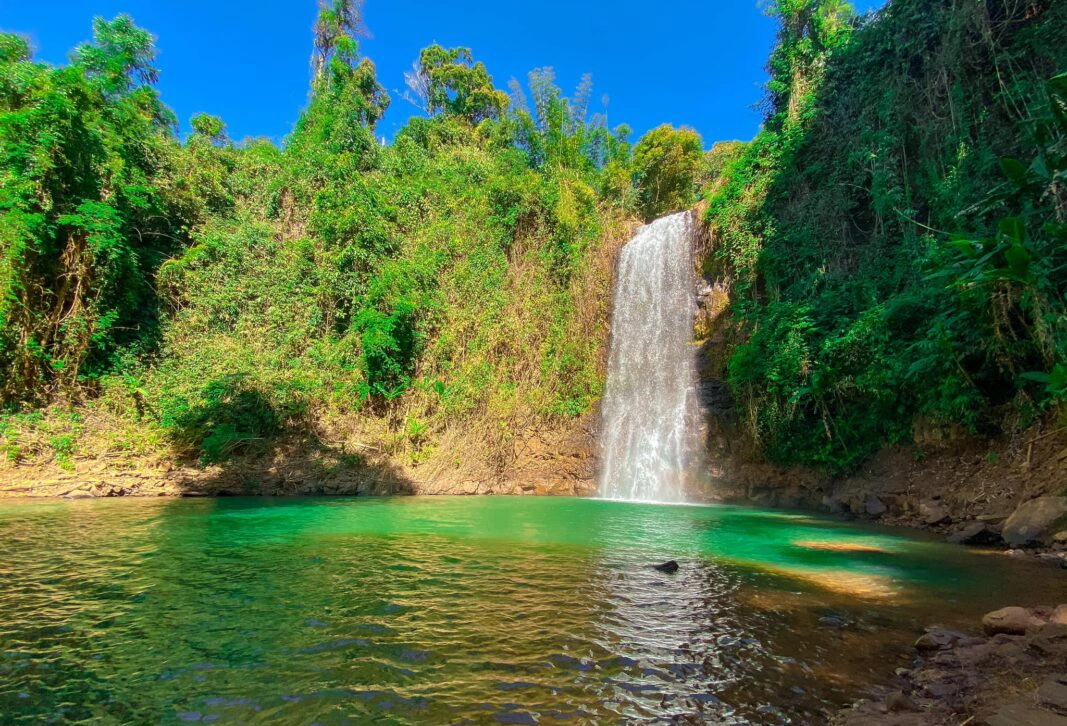
The Pa Sy Waterfall Ecotourism Area features a network of paths, communal houses, handicraft workshops, cultural galleries, and vegetable and flower farms. The centerpiece of this tourist area is Pa Sy Waterfall, situated at an altitude of around 1,500 meters above sea level. Formed by the convergence of the three largest streams in Mang Den, the waterfall is also called Pau Suh in the local language, which means "three-source stream."
Dak Ke Lake

Located in the heart of Mang Den Town, Dak Ke Lake, also known as Toong Ro Poong Lake, spans approximately 3 hectares. The lake has undergone development to offer a range of entertainment services, including boating, fishing, and dining. Visitors can also rent buffalo-drawn or horse-drawn carriages to explore the lake's surroundings and admire the scenery. During the summer, the area comes alive with the blossoming of purple phoenix trees, while mai anh dao grace the landscape in winter.
Picking fruits and vegetables on farms
Mang Den Town has been designated by Kon Tum province for the development of high-tech farms, aiming to produce clean and fresh fruit and vegetable products. Visitors to Mang Den can enjoy the experience of fruit picking directly from the gardens. Oranges, pomelo, avocados, tomatoes, strawberries, cantaloupes, as well as flowers like chrysanthemums and lilies are among the most popular produce. These farms do not charge an entrance fee, allowing visitors to harvest the products. However, if visitors wish to bring the fruits and vegetables home, separate charges will apply.
Recommended farm locations include E Ban Farm, Orfarm, Biophap, Mang Den Xanh Farm, Tam An Organic Farm, and Hung Ly Garden.
Garden of wooden statues
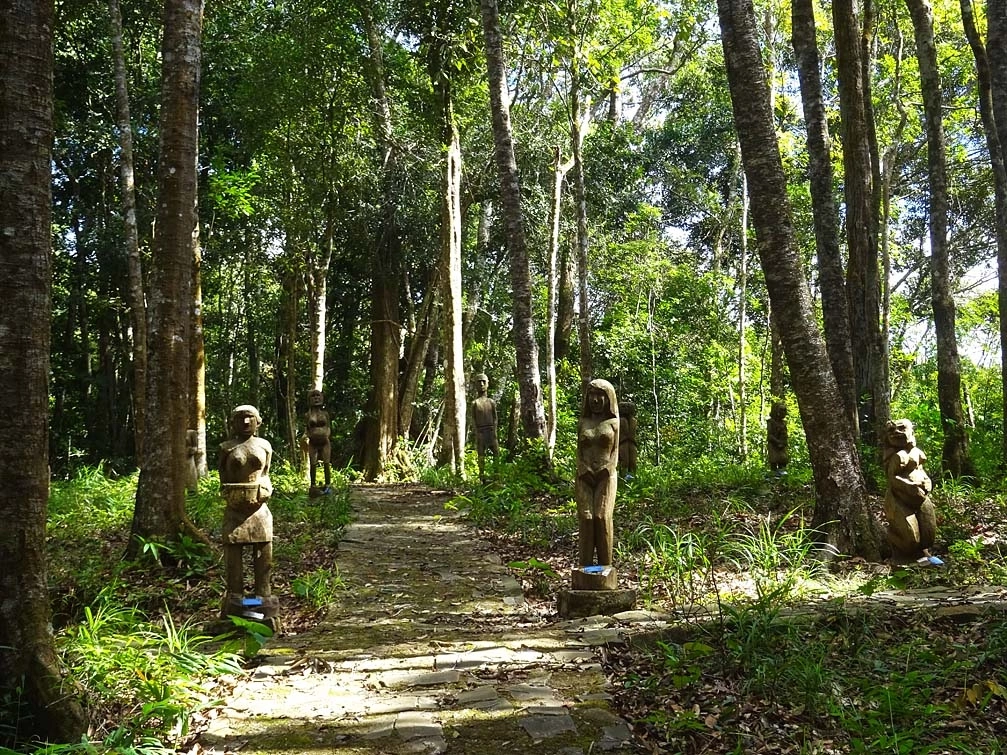
The forested garden of wooden statues showcases a collection of figures placed along the path. Photo courtesy of Kontumtrongtoi
Established in 2013, the garden of wooden statues occupies over 1 hectare of pristine forest near the Pa Sy Waterfall area. Alongside well-paved paths, the garden features 100 wooden statues meticulously crafted by 33 local artisans belonging to ethnic minority groups from the province. These statues depict various aspects of the daily lives and work of the North Central Highlands, showcasing scenes such as men wielding axes, engaging in smoking or hunting, women pounding rice or weaving, and people playing music or drinking can wine, a Vietnamese fermented rice wine. The collection also includes statues of animals closely associated with the local culture, such as birds, dogs, cats, pigs, monkeys, snakes, and elephants.
Khanh Lam Pagoda
Khanh Lam Pagoda spans 10 hectares and sits at an elevation of 1,200 meters above sea level. Visitors embark on a journey from the foot of the hill, ascending over 200 stone steps through a tam quan gate, a traditional Vietnamese Buddhist gateway with three aisles. Finally, they reach the temple, which nestles amidst the trees. Notably, the main hall showcases a three-storey roof structure that fuses traditional pagoda and communal house architecture, reflecting the cultural identity of the Central Highlands. The main hall is surrounded by a bell tower, a drum tower, a 17-meter statue of Guan Yin Bodhisattva, and a symmetric lotus pond, creating a tranquil landscape.
Mang Den Walking Street
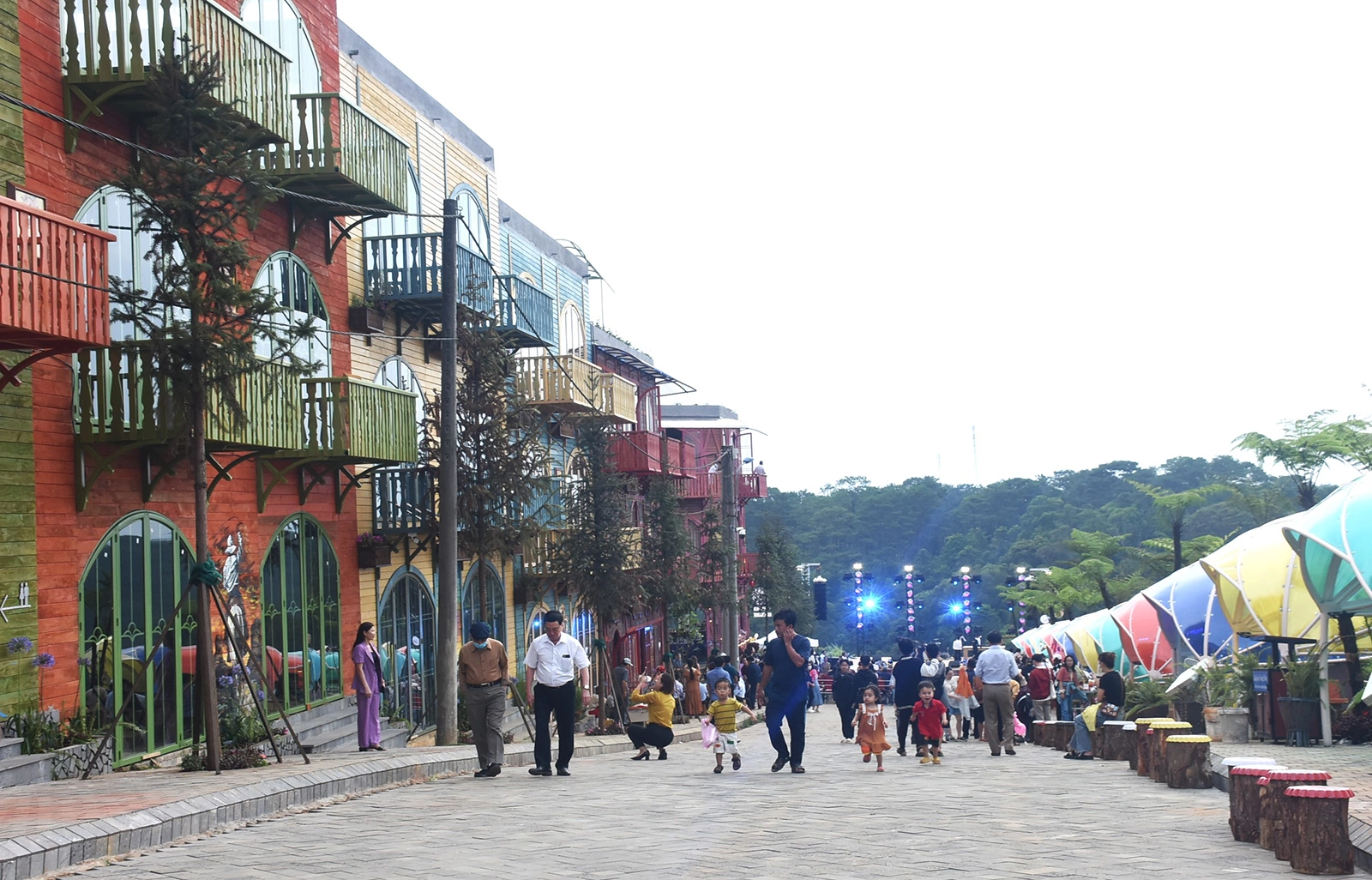
Mang Den Walking Street showcases a vibrant array of colorful buildings lining its sides. Photo courtesy of Kontum Online
Mang Den Walking Street, also referred to as Sunset Boulevard, is situated along Vo Nguyen Giap Street in the heart of the town. This pedestrian street features a range of hotels and restaurants with beautifully designed architecture. The ambiance is enhanced by the surrounding elements of water, sky, and clouds, creating a serene atmosphere for tourists to unwind and savor the local cuisine.
Given its small size, Mang Den offers limited options in terms of large hotels. The Golden Boutique Hotel, a 4-star establishment, boasts 63 fully-equipped rooms with large windows and balconies, along with a swimming pool. Another choice is the Dak Ke Mang Den, a 3-star hotel featuring four villas, a stilt house, and two hotel suites, totaling 45 rooms.
Homestays constitute the primary form of accommodation in the area. Mang Den's homestays are reasonably priced, ranging from VND300,000 to VND800,000 per room per night. Dormitory-style rooms are also available, with prices ranging from VND150,000 VND to VND250,000 per bed. Some recommended homestays include Toki, Paradiso, May Lang Thang, and Sun Homestay.
Xuyen Tieu hot pot
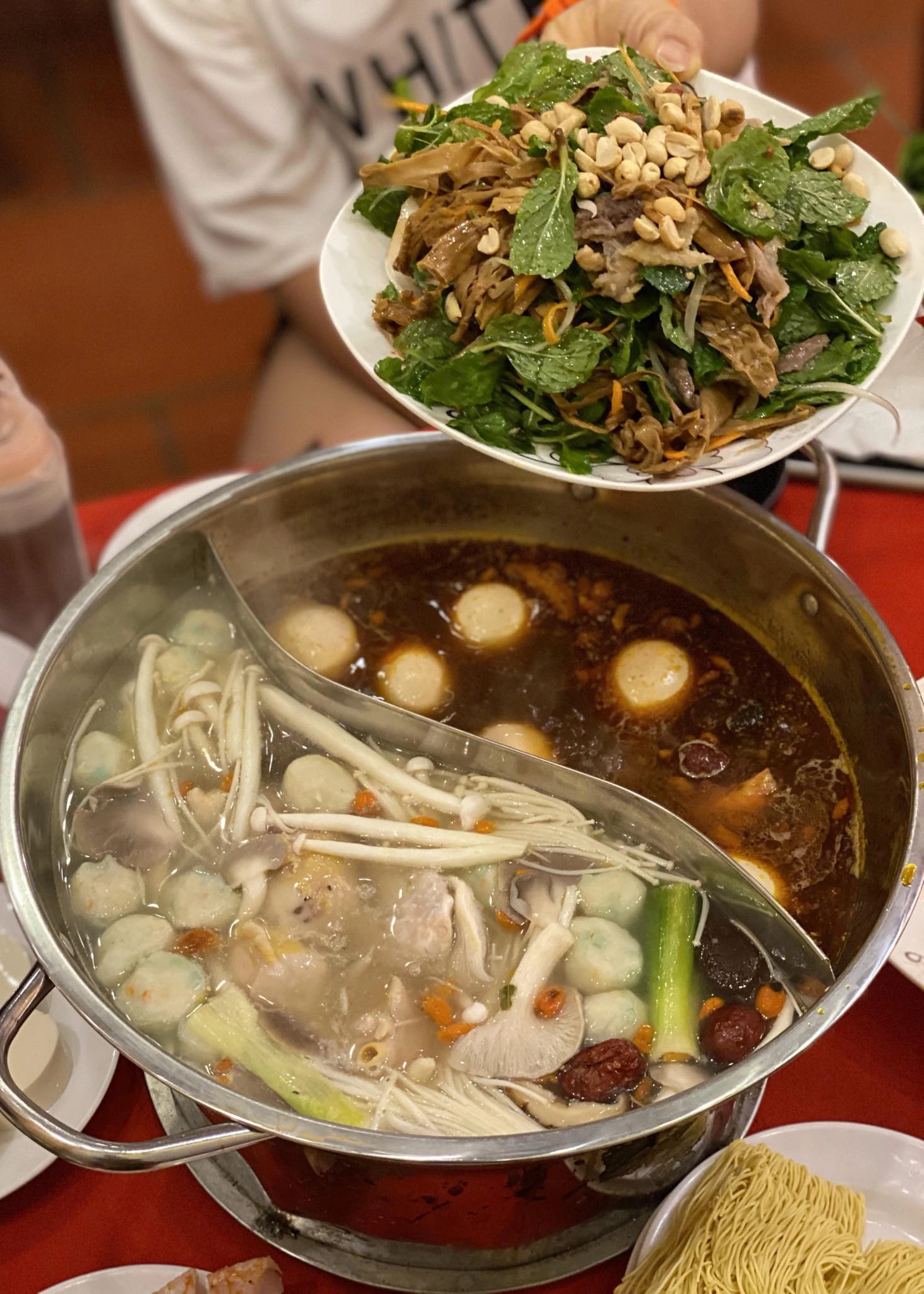
Xuyen Tieu hot pot with pepper is a dish perfectly suited for Mang Den's chilly weather. The hot pot is prepared with a medley of vegetables and fruits, infused with flavorful herbs like goji berries and dried red apples. The broth is simmered for hours, resulting in a natural and delightful sweetness.
Xuyen Tieu hot pot is served in a manner similar to Sichuan hot pot, featuring two compartments with distinct flavors. One side features a hot and spicy broth, infused with the flavor of Xuyen Tieu, a wild pepper variety. The other side offers a cool and rich bone broth. The hot pot is served with a selection of dishes such as fish, shrimp, chicken, or beef, along with mushrooms and fresh green vegetables. To savor the full essence of the dish, diners are encouraged to taste the spicy broth first.
Dried bamboo shoot chicken salad
Dried bamboo shoot chicken salad combines two key ingredients, chicken and dried bamboo shoots, with peanuts, mint, onion, and carrot. This dish, though reminiscent of other salads, still surprises diners with its blend of sweet and tangy flavors.
Banh canh ca loc (Snakehead fish thick noodle soup)
The noodle soup is crafted from rice flour, accompanied by steamed snakehead fish. The fish fillet is separated, complemented by green onions, coriander, laksa leaves, and chili peppers. One remarkable characteristic of banh canh ca loc is the individual cooking method. Each serving is cooked in its own pot, ensuring the soup remains piping hot with a continuous boil. Diners can add prostrate knotweed to the soup and relish this combination. One place to try the soup is Mang Den Market.
Grilled chicken and com lam (rice in bamboo tube)
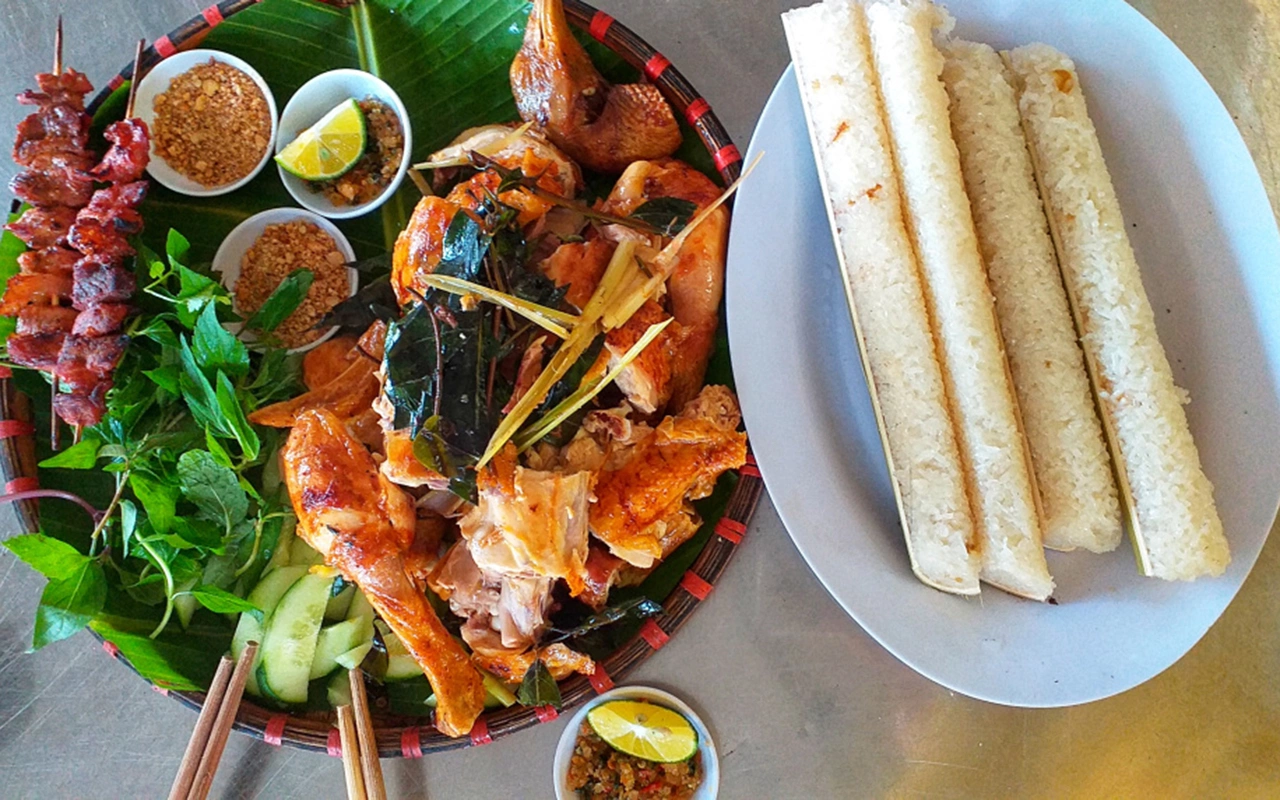
This traditional local delicacy features free-range chickens, resulting in succulent meat. Before grilling, the chickens are infused with wild pepper leaves, onions, lemongrass, chili, and other aromatic ingredients. The charcoal grill must be sufficiently hot, with each batch taking around 20 to 30 minutes to cook. Grilled chicken is best enjoyed while hot, offering crispy golden skin and fragrant meat. The dish is often served with com lam, a type of sticky rice cooked in bamboo tubes, and a dipping seasoning of peanut salt or sesame.
Tourists can try the dish at Ga nuong Co Sinh restaurant along National Highway 24.
Some other restaurants to try Mang Den specialties are Mang Den Lu Quan at 55 Ngo Quyen Street, Dak Long Commune, KonPlong District; Tay Nguyen Quan at 35 Truong Chinh Street, Dak Long Commune, KonPlong District.
Travelers from Hanoi are advised to opt for the flight route, considering the considerable distance of approximately 1,100 kilometers. The nearest airport to Mang Den is Pleiku in Gia Lai Province, which is roughly 100 kilometers away, taking about 2 hours by car to reach the destination.
For those journeying from Ho Chi Minh City, they can take a self-driven trip along Highway 14. The route spans around 600 kilometers, passing through provinces such as Binh Phuoc, Dak Nong, Dak Lak, and Gia Lai.
Buses departing from Ho Chi Minh City's Eastern Bus Station offer another convenient option. Operators such as Long Van, Minh Quoc, Phong Phu, and Phuong Thu provide services with fares ranging from VND250,000 to VND450,000 ($10.63 to $19.13). The travel duration typically ranges from 10 to 12 hours.
Within Kon Tum City, various means of transportation, including taxis, buses, and self-driving cars, are available to reach Mang Den.
Due to its steep and winding nature, it is important to exercise caution while driving on the road to Mang Den.
Mang Den can get cold in the early morning and evening, so tourists should be prepared by bringing warm clothing to stay comfortable.
Story by Tam Anh